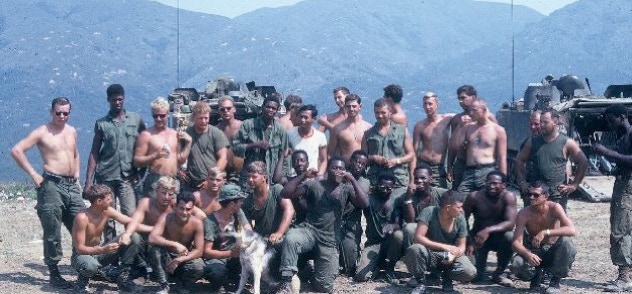

“Sarge” surrounded by members of F Troop 17th Cavalry (3rd. Plt)
at LZ Jane in 1969. Photo by Sgt. Charles Norred
Welcome. This web site was developed for the sole purpose of providing a simple snapshot in time, of and for the men and dogs of just one of the many dog units that served in-country – the 48th “Hell On Paws” Scout Dog Platoon.
From WW I to the present day, the U.S. military has enlisted the aid of dogs in a variety of roles. The Vietnam War was no exception. Due to the nature and escalation of the war, in 1965 the U.S. Army decided to reactivate its scout dog program. The first Army scout dog platoon was deployed to Vietnam in June 1966, when the 25th IPSD arrived at Tan Son Nhut Air Base. Between late 1965 and January 1969, twenty-two Army Scout Dog Platoons and four Marine Scout Dog Platoons were deployed to Vietnam.
It is believed that over 9,000 handlers (Army, Air Force, & Marine combined) and 4,000 dogs (Scout, Combat Tracker, Sentry, Mine & Tunnel) served in Vietnam. Of the 294 dog handlers who were killed in Vietnam, one handler, Staff Sergeant Robert W. Hartsock from the 44th IPSD, received the Congressional Medal of Honor posthumously for extraordinary heroism and bravery in defending against a sapper attack on the Dau Tieng Base Camp, Hau Nghia Province, RVN
The dog units that served in Vietnam earned much deserved respect for their work. As in previous wars, they still remained a small element and could provide only a limited impact. If viewed on a grand scale, their accomplishments remain minor. But when an analysis is made based on their numbers in the field, their impact was significant.
While they recorded many successes, dogs did not always work up to expectations. Many factors, including health, terrain and weather conditions, all impacted a team’s success. Scout dog teams worked on a rotation basis (average 3-5 day missions in the 48th IPSD) and balanced their amount of time in the field with rear and forward base camp responsibilities between missions. Above all, the dog handlers had the utmost respect for the line units and the soldiers they were sent to support; many whom endured much longer periods in combat conditions with only occasional relief.
Sadly, in spite of their contributions to the war, the final disposition of these beautiful animals was shameful. The Military considered the dogs to be equipment and to be disposed in the most cost efficient way. In 1970 and 1971 when most of the dog units were being deactivated, the dogs were euthanized or were given to the untrained ARVN Troops (Army of South Vietnam) to an uncertain fate. Despite some very real concerns about possible contagious diseases (Ehrlichia canis) if returned to CONUS (CONtinental United States), the final disposition of the dogs at the end of their Vietnam service was both disgraceful and immoral.
When compared to the big picture - the thousands of bombs dropped, huge engagements with hundreds or thousands of infantrymen killed or wounded - the effectiveness of the dogs in Vietnam will always be subjective and open to debate. Yet for the dog handlers and the countless thousands of soldiers they worked with in the field, whether they came home in one piece, wounded, or came home at all, their fate frequently rested upon the ability of the dogs and their handlers.
